Explore Peru’s Fascinating Chankillo Ruins and Discover the Mysterious Backstory
Most kids go through a phase of wanting to be an archaeologist (usually after watching one of the Jurassic Park movies). While the majority of us end up pursuing other careers, that spark of interest in ancient ruins and mysterious artifacts never truly dies. If you’ve found your way to this article, then you’re probably one of those infinitely curious people who never quite grew out of their fascination with the unknown.
You’re certainly in the right place as we’re about to embark on a digital expedition to the crumbling remains of the Chankillo fort. Tucked deep within the Peruvian coastal desert, this UNESCO World Heritage site offers a fascinating link with unusual human practices of the past. Let’s dive in, shall we?
Cosmic construction
The fort comprises thirteen stone towers, a couple of observation platforms, and in true Indiana Jones style, a mysterious temple. As you can see in the picture, it was once a well-guarded fortress with concentric defensive walls designed to ward off intruders.

Source: IDARQ/UNESCO
The archaeological site was heritage-listed in 2021. However, experts have been exploring it and puzzling over it for over 100 years. Was it the site of cult rituals and strange sacrifices? Or did ancient humans possess scientific knowledge to rival our own?
A land before time
Through carbon dating, scientists have confirmed that Chankillo was constructed around 2,300 years ago – long before the common era. Though we don’t know for sure when it was abandoned, we do know that it was rediscovered by the 1800s century (possibly before).

Source: IDARQ/UNESCO
While modern humans have been aware of the site for quite some time, it wasn’t until our time – the 21st century – that anyone was able to uncover its hidden purpose.
Why so mysterious?
Speaking to the BBC in 2007, Emeritus Professor of Archaeoastronomy Clive Ruggles expressed shock at the fact that it took us so long to determine the purpose of Chankillo’s impressive towers.

Source: MI PERÚ/Flickr
Ruggles, who teaches at the University of Leicester, said that he was “gobsmacked when I saw them for the first time.” As you explore the pictures beyond, try to imagine yourself in the desert, gazing up at the ancient structures. You’re sure to experience at least a tiny spark of the same wonderment Ruggles felt.
Venturing into the desert
To reach the Chankillo fort, you must travel deep into the Casma Valley, which is part of the coastal desert of Peru. Once there, you’ll be on the lookout for the reptilian ridge you can see in the image below. Once you spot them, you know you’re in the right place.

Source: IDARQ/UNESCO
Count the spikes on the spine of this hill (which looks like a sleeping dragon), and you’ll note that there are 13 of them. Those are the mysterious towers of the Chankillo complex.
Towering in the wilderness
Those who reach the fort get to enjoy the deeply satisfying but ever-so-slightly creepy feeling of being alone in a vast expanse of nothingness. Empty desert stretches all around, but a puzzling mystery and the key to ancient scientific wisdom lie ahead.

Source: Werner Forman/Universal Images Group/Getty Images
The rectangular towers at Chankillo reach into the sky at a height of between 6 and 20 feet. Those height differences are likely due to the effects of time and harsh desert weather. They are, after all, more than two thousand years old.
Top of the tower
Though the towers themselves are impressive, it’s the way they’re arranged that has scientists like Ruggles so intrigued. They run from north to south across the desert ridge, with perfectly even gaps between each one.

Source: Werner Forman/Universal Images Group/Getty Images
That is what creates the serrated appearance and brings to mind the image of a sleeping dragon. It also offers a clue to the fort’s original purpose.
Now, it’s time to climb the path that will lead us closer to the ancient complex.
Secret stairs
Like all good ancient mysteries, the Chaqillo fort comes with lots of fun discoveries, the first of which is the secret staircase. Actually, there are 13 hidden staircases – one for each tower.
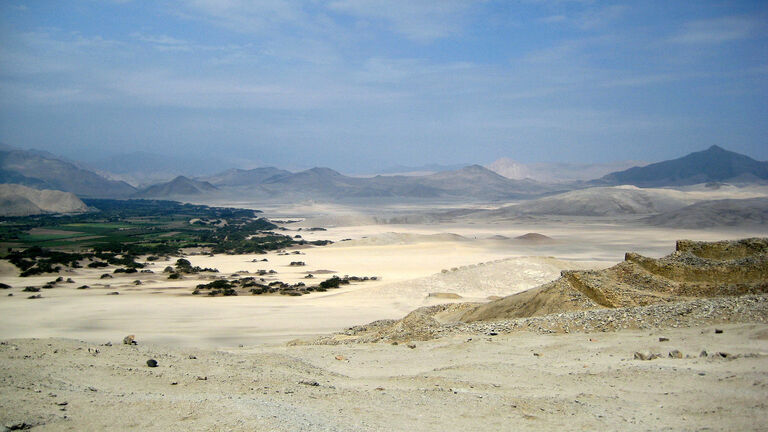
Source: Vuelo Directo Travel/Instagram
The view from the top is certainly stunning. However, pretty vistas did not inspire the creation of this ancient structure. No, the Chankillo complex was built with a far grander purpose in mind. Let’s explore deeper and uncover more hidden elements in this ancient complex.
Rituals and battles?
Literature reveals that Chankillo was rediscovered sometime in the 1800s. Though it could be earlier, that’s when we start to see written records of it. Back then, those who knew about the strange ancient site had endless wild theories about its purpose.

Source: Werner Forman/Universal Images Group/Getty Images
Over the centuries, these theories only got wilder, with people speculating that it was a battleground for ritualistic fights or perhaps some kind of cultish sacrificial locale. The creepy part is that there was some evidence to support such theories.
Protecting something?
As you can see from the picture, the ruins look like they were once designed to protect something. However, as we’re about to learn, looks can be deceiving – especially when you’re dealing with ruins so ancient that much of their detail has long since been consumed by the desert.

Source: Werner Forman/Universal Images Group/Getty Images
Some of the walls surrounding the buildings in the Chankillo complex stand 20 feet high. Coming up, we have pictures of the ringed battlement-style walls, and you’ll see that they are highly suggestive of a defensive structure.
Exploring the battlements
So, the ridges you’ve already seen look like outposts of some kind – a way to keep an eye out for the enemy. However, they are only one part of the greater Chankillo complex. Below, you can see one of the towers and the concentric rings of battlements surrounding it.

Source: IDARQ/UNESCO
With these factors combined, Chankillo begins to look like a well-protected fort designed to keep intruders at bay. But what were they guarding out in the middle of the desert?
When was Chankillo built?
To uncover its secrets, we need to consider the historical period during which Chankillo (also known as Chanquillo) was constructed. That time is known as the Early Horizon period, which spanned 900 – 200 BCE. Chankillo was built sometime around 400 BCE.

Source: Werner Forman/Universal Images Group/Getty Images
While its remains are mostly crumbling rubble, there’s plenty of evidence to suggest that its fortifications were once robust and intelligently designed. It’s reasonable to expect that the people of the past would want to protect themselves, but something about this “fort” just wasn’t adding up for modern scientists.
A fort with fatal flaws
Though Chankillo’s walls seem impressive, even at their prime, they wouldn’t have been sufficient to fend off an invading force. The construction was solid enough, but the design just wasn’t ideal for a fortress.

Source: Werner Forman/Universal Images Group/Getty Images
Archaeologists diligently documented these “design flaws” until they came to the conclusion that they may not have been flaws at all. Perhaps the error lay in their assumption that Chankillo was a fort.
Secret passages and hidden entrances
While the staircases, passages, and entrances to the buildings had long since crumbled, archaeologists were able to reveal many of them. Indeed, Chankillo was a hive of passages and access points, hinting at a far more mysterious past than scientists had initially suspected.

Source: Werner Forman/Universal Images Group/Getty Images
If there was a class called “Fortress Building 101,” the first lesson would be to avoid placing multiple entrances in the walls of your fort. After all, the idea is to keep the enemy out, not give them various ways to get it.
A new understanding of Chankillo
At this point, it’s safe to say we can give up on Chankillo being a fortress. But if it’s not a fort, then what on earth is it? Thankfully, we have experts on hand to make sense of the ancient clues and reveal the secrets of these desert-bound structures.

Source: yonel alberto campos gamonal/Flickr|CC BY 2.0
It was time for a new theory, which meant there was a flurry of debate among archaeologists, each taking a different angle in guessing what the purpose of the complex might be. One of the most interesting suggestions arose from the fact that it seemed a religious level of care had been taken in maintaining the buildings.
More than just a fort
Of course, Chankillo was in ruins, but given its age and the climactic intensity it endured in the desert, the complex was remarkably well-preserved. There were still plenty of clues to be found in its walls, and this fact alone gave scientists a valuable lead.

Source: David Edgar/Wikimedia Commons|CC BY-SA 3.0
The site appeared to have been a cherished and perhaps even a holy place. With that, interest in Chankillo grew. By 2001, a new expedition set off to explore the ruins. Their mission was to determine the true purpose of the place.
Was Chankillo a cult temple?
Across times and cultures, one thing is true of humans – we tend to take great care when protecting and preserving our holy sites. Guided by this fact, the scientists on the expedition wondered whether Chankillo may have been a temple or the locale for cult rituals.
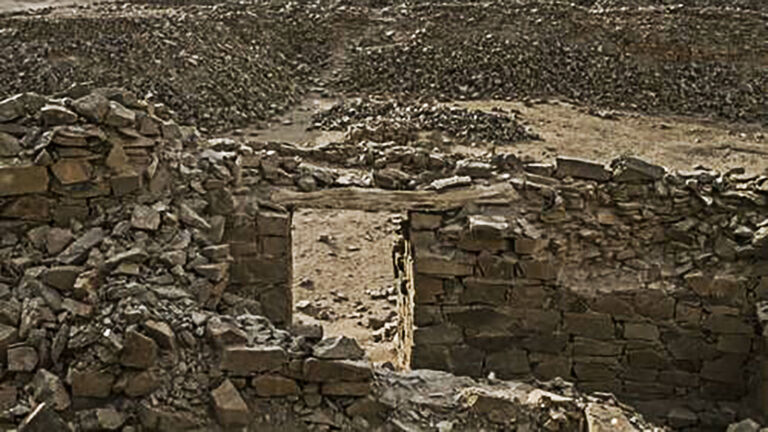
Source: IDARQ/UNESCO
This idea didn’t arise out of thin air. The experts on the expedition had been to many ancient cultic sites, and they could see clear connections between these places and the ruins of Chankillo. Of course, that presented a new question – what could this cult have been worshiping?
Who built Chankillo?
If you’re a fan of the BBC show Wonders of the Universe, you may remember its host, Professor Brian Cox, visited Chankillo. Of course, that was nearly a decade ago, so we’ll forgive you if you don’t remember all the details!

Source: IDARQ/UNESCO
In the episode, Cox spoke about the people who lived in the region 2,300 years ago – the people who must have built Chankillo. Unfortunately, he didn’t have much to say apart from revealing the fact that we know very little about this ancient population.
A people lost in time
According to Cox, there’s very little evidence to go on. Historians know as little about the culture as they do about the language spoken in Peru at the time. So, sites like Chankillo are vital links to this heavily shrouded part of human history.

Source: IDARQ/UNESCO
Essential though these ruins are to understanding the past, our lack of knowledge also makes them challenging to interpret. So, scientists have a dilemma on their hands – they need the ruins to learn about the Early Horizon period, but they need to know more about the Early Horizon period to understand the ruins.
The ghosts of Chankillo
Of course, there are no ghosts in the supernatural sense. However, there are ghostly traces of the magnificent structures that once stood on the site. Though they’re crumbling now, the walls contain evidence that they once glowed in the desert sun.

Source: Werner Forman/Universal Images Group/Getty Images
There are also small fragments of decorations that once made Chankillo a sight to behold. Small though these fragments are, they’re enough to give researchers a clear picture of what the ruins looked like in their prime.
Revealing secrets with science
If you dig up the Wonders of the Universe episode on Chankillo, you can hear Professor Cox explain that “if you stand in the right place, you can still experience the true purpose of Chankillo, just as you could the day it was built.”
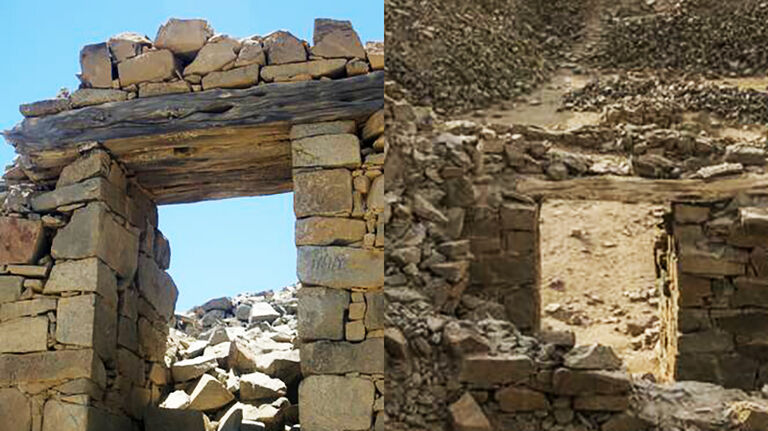
Source: IDARQ/UNESCO
Professor Cox knew this back in 2013 because, by that time, the expedition we mentioned earlier – the one that left in 2001 – had revealed their remarkable findings. Finally, there was an answer to Chankillo’s mystery that was more than just conjecture.
Dr. Ghezzi and Professor Ruggles
It took around six years for the researchers heading up the expedition – Dr. Ivan Ghezzi and Professor Ruggles (whom we met earlier) – to publish their findings. However, as you’re about to discover, the long wait was well worth it.

Source: Werner Forman/Universal Images Group/Getty Images
If you’re interested, you can find the report published by Dr. Ghezzi and Professor Ruggles in one of the 2007 editions of the Science journal. Dr. Ghezzi was studying fortresses at the time as they were central to his doctoral thesis. With this area of expertise, he was quickly able to spot that Chaquillo was not a fortress.
A new idea
As he explored the site, Dr. Ghezzi became more and more convinced that the place would not help him with his Ph.D. However, that didn’t mean he was ready to give up and go home. On the contrary, he and his colleagues realized they were on the precipice of a momentous discovery.

Source: yonel alberto campos gamonal/Flickr|CC BY 2.0
They got to work on the site, exploring its many structures, recovering artifacts and clues, and piecing together the fragments. Before long, a new theory emerged.
Leveraging a unique opportunity
When we say the theory was “new,” that’s not entirely fair to past researchers. In fact, as far back as the 19th century, there was speculation that Chankillo may have had some connection to the solar system.

Source: Werner Forman/Universal Images Group/Getty Images
The problem was that, as Dr. Ghezzi explained to Yale News in 2007, “no one followed up on it,” The idea seemed sound and supported by the evidence they had gathered thus far. So, despite the fact that it would slow down progress on his Ph.D., Dr. Ghezzi decided to study the place.
Early discoveries
Once the fortress idea was definitively cleared from consideration, the scientists were able to view the evidence in a new and more accurate light. They quickly pieced together the true nature of the Chankillo complex.

Source: GeoEye/SIME
Speaking to The New York Times, Dr. Ghezzi confirmed that “in the first hours of measurements, we realized the nature and importance of the towers.” Still, they didn’t rush to publish. Indeed, they took a full six years – plenty of time to test the evidence and back up their theory.
Cosmic connection
At this point, it will help if we take a bird’s-eye view of the site. As you can see, the entire complex is quite spread out. Soon, the scientists deduced that the walled-in towers you can see in the image below were part of an observation station.

Source: GeoEye/SIME
This observation deck stands about 750 feet away from the ridge of 13 towers we examined earlier. By measuring the relevant distances and examining the lay of the land, the scientists were able to deduce the true purpose of the place.
Aligned with the sun
This picture gives you an even clearer overview of the entire Chankillo complex. As it turns out, the ridge of 13 towers aligns in precisely the way needed to accurately track the trajectory of the sun across the sky.
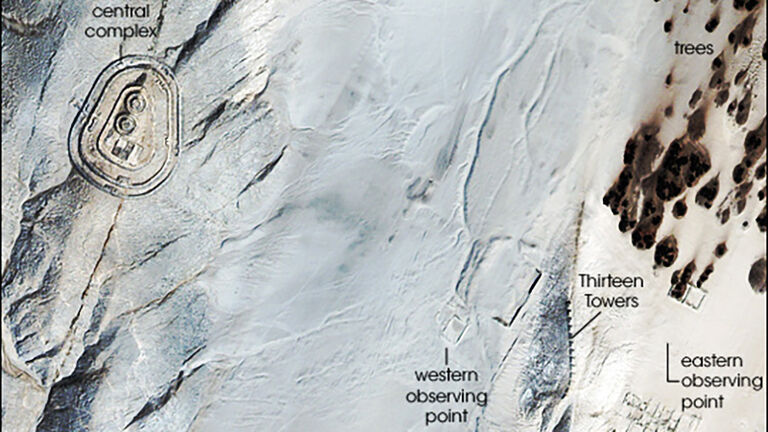
Source: GeoEye/SIME
By analyzing sunrise and sunset from the observation deck, you could tell with an astonishing degree of accuracy what season it was. The scientists never doubted the ingenuity of ancient humans, but they were still shocked at this remarkable discovery.
Tracking solar movements
As advanced as this ancient technology was, it was also quite simple to use. All you have to do is stand at the observation deck at sunrise, check where the sun emerges in relation to the towers, and you can figure out what season it is.
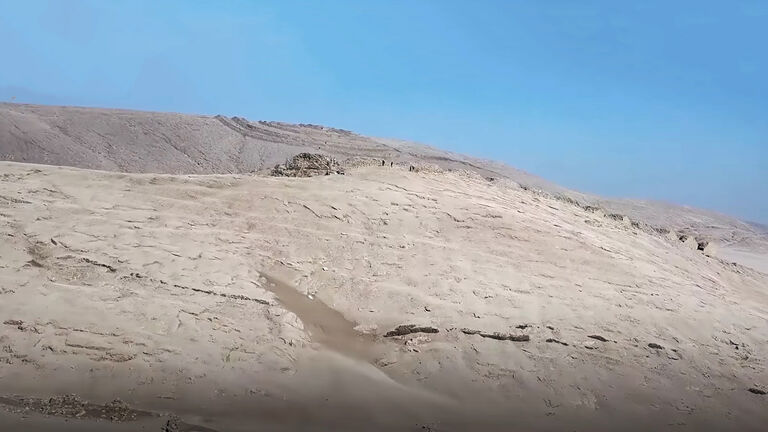
Source: World Monuments Fund/YouTube
Of course, you need to be pre-armed with an understanding of cosmic patterns and their impact on our planet’s seasonality. In other words, the people who lived more than 2,000 years ago were pretty well-versed in the movements of our solar system.
Is Chankillo the world’s largest calendar?
This solar tracking device was, in effect, a calendar. Refer to it, and you could tell what time of year it was. Given its remarkable size, it’s quite possible that Chankillo is the largest calendar in the world.
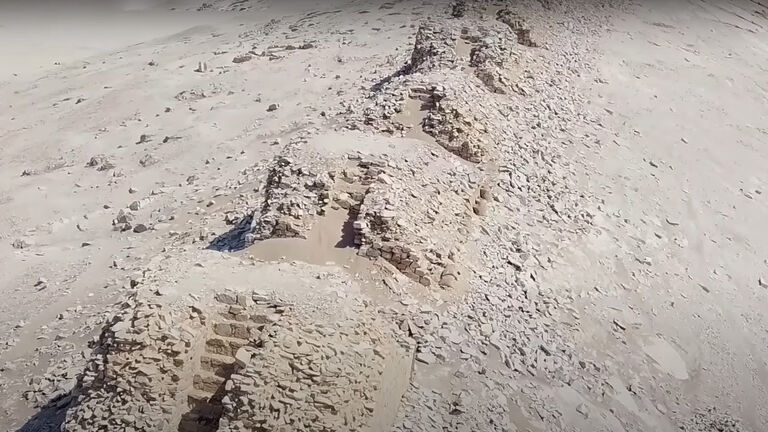
World Monuments Fund/YouTube
In the modern era, we only have to pull out our smartphones to see the date and get an idea of what the weather will be like later in the day or week. However, in 400 BCE, they had to trek out into the desert to confirm whether it was a good time to plant crops.
A groundbreaking revelation
Using this magnificent time-telling device, the ancient civilization could reveal with absolute precision when the summer and winter solstices were. They could also plot the spring and autumnal equinoxes, meaning they could accurately time their crop planting, harvests, and other seasonal activities.

Source: World Monuments Fund/YouTube
As you can probably imagine, this was a groundbreaking discovery for the modern team of scientists. They had cracked the ancient code, giving us a window into a previously inaccessible part of human history.
Chankillo – an ancient solar observatory
To date, Chankillo is the oldest solar observatory on record. That means the people of this time were remarkably advanced, making it even more frustrating that we don’t have more relics to analyze.

Source: World Monuments Fund/YouTube
In addition to being advanced for its time, Chankillo also differs from other ancient astronomical observatories. Perhaps the most significant difference is that it can tell the time, with precision, all throughout the year. In effect, this pushed back the rise of organized civilization in the Americas by a good 500 years.
Older than Maya ruins
Similar solar observatories have been found in Europe and in other parts of South America. However, Chankillo is older than all of them. It beats the oldest Maya observatory by about 500 years, and the Europeans are even further behind.

Source: World Monuments Fund/YouTube
According to Dr. Ghezzi, Chankillo is around 1,800 years older than the most ancient astronomical observatories in Europe. The wildest part is that this human capability could be even older – we just haven’t yet found any ruins or artifacts to prove the theory.
The significance of Chankillo
We’ve already hinted a little at the grand purpose behind Chankillo. If you’re planting crops, storing food, and otherwise planning for the future, it’s incredibly helpful to know what time of year it is and what weather you can expect over the coming months.

Source: World Monuments Fund/YouTube
However, it’s likely that the civilization of the time also used their giant calendar to confirm the right time to celebrate seasonal religious festivals. Amazingly, there may have been an even grander purpose for the Chankillo complex.
Guided by the sun
Polytheism and pantheism were common in Peru, with its ancient civilizations experiencing natural phenomena as divine forces. It was common for rulers of the region to be “guided by the sun” when making political decisions and other decrees, as the sun was a deity in Inca culture.

Source: World Monuments Fund/YouTube
In fact, one Inca king declared himself a direct descendent of the sun god, so it stands to reason that powerful monarchs may have used observatories like Chankillo to seek guidance from this god. In fact, since it outdates other ruins in the region. Chankillo could point to the origin of such ideas.
Controlling the gods
Having direct communication with the gods is pretty impressive in and of itself. However, when you control access to the gods, you control the messages and orders they give. In other words, you own the gods, and by owning them, you control the people.

Source: World Monuments Fund/YouTube
According to Dr. Ghezzi and Professor Ruggles, the imposing nature of the 13 towers could have been a sign to the people that the person who commanded that mysterious and imposing place had knowledge and power far beyond their comprehension.
A genuine ancient astronomical observatory
Though much of its power has eroded over time, the Chankillo complex still inspires a creeping sense of awe. Picture yourself out in the middle of the desert, far from human civilization, staring up at these mysterious, crumbling structures from another era.
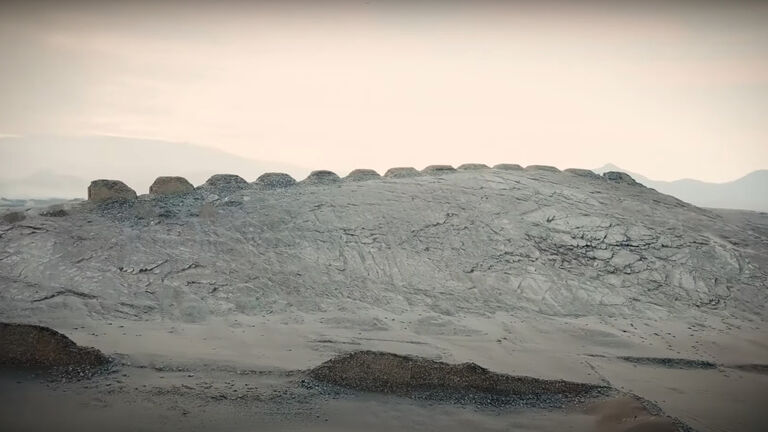
Source: World Monuments Fund/YouTube
That was precisely what Professor Ruggles found himself doing while working at the site. Though most ancient astronomical observatories end up being a letdown in one way or another, Chankillo exceeded every expectation the scientist had. The craziest part is that we still don’t know all its secrets.
An extraordinary discovery
Speaking to Yale News, Ruggles concluded, “Chankillo is one of the most exciting archaeoastronomical sites I have come across.” He was surprised that no previous researchers had thought that it might be a solar observatory. However, this is an excellent example of “failing to see the forest for the trees.”
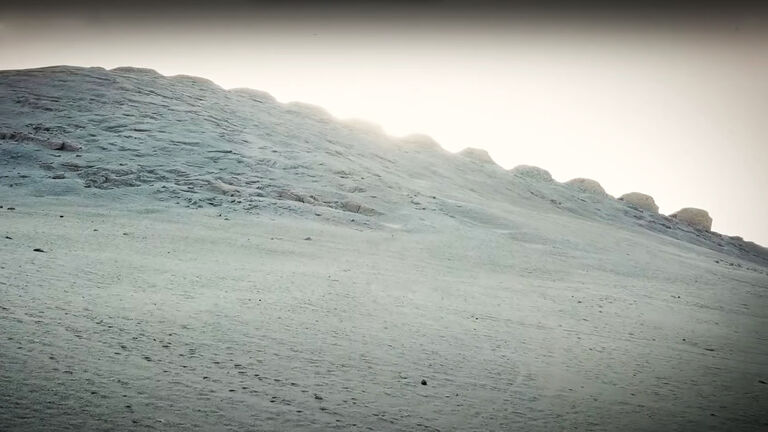
Source: World Monuments Fund/YouTube
Previous researchers saw towers and heavy-duty walls, and they couldn’t get the idea of a fort out of their heads. No suitable theory was arrived at for the contradicting evidence, and Chankillo was left a mystery – until Ruggles and Ghezzi arrived on the scene.
Another secret revealed
The two adventurous scientists made yet another important discovery – one that supports the “controlling the gods” hypothesis raised earlier. The viewing platform was only large enough to fit three people at most. In other words, this was not a place where just anyone was welcome.

Source: World Monuments Fund/YouTube
Speaking to the BBC, Ruggles explained the importance of this finding. Few people would have been authorized to watch the sunrise from this very special vantage point, ensuring that the wisdom gained from Chankillo was reserved for the elitist of an elite class.
Rituals and ceremonies at Chankillo
The evidence described above also suggests that trips to the Chankillo viewing platform were sacred. In Ruggles’ words, “All the evidence suggests that there was a formal or ceremonial approach to that point and that there were special rituals going on there.”

Source: World Monuments Fund/YouTube
The time of year – something we can all check with a glance at our smartphones – was secret knowledge reserved for a special class of influential people. Everyone else just had to trust their judgment, wisdom, and relationship with the gods.
Priests with power
Though we have very little evidence to go on, the traces of relics and other elements at the site suggest a temple-like architectural style. So, speaking to the BBC, Professor Ruggles hypothesized that it was probably a priest (or priests) who had special access to the place.

Source: World Monuments Fund/YouTube
The ruins of some kind of plaza lie within the vicinity of Chankillo, and this is likely where the crowd waited for the verdict. Without access to the right vantage point, the crowds would have seen the sunrise but never from the angle needed to unlock Chankillo’s secrets.
Real-world magic
This brings to mind that famous quote from science-fiction author Arthur C. Clarke – “any sufficiently advanced technology is indistinguishable from magic.” To the people of this time, Chankillo must have been magical. Indeed, it still holds a sense of enchantment to this day.

Source: World Monuments Fund/YouTube
After all, the Earth is still orbiting around the sun, so the Chankillo structure continues to work perfectly well as a solar observatory. That is good news for those who like wandering in the desert – if you head to Peru’s coastal desert, you’ll always be able to tell what time of year it is.
